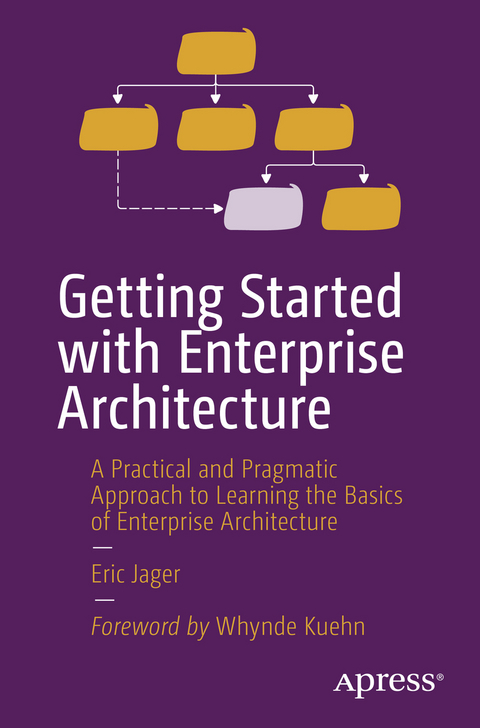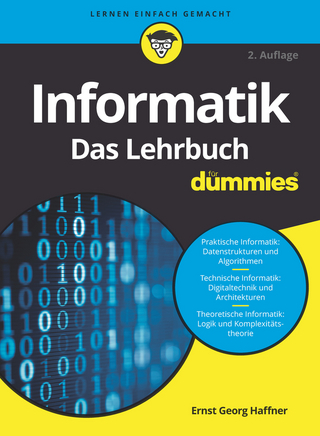
Getting started with Enterprise Architecture
Apress (Verlag)
978-1-4842-9857-2 (ISBN)
The book's pragmatic approach keeps existing architecture frameworks and methodologies in mind while providing instructions that are readable and applicable to all. The Enterprise Architecture Implementation Wheel builds on the methodology of existing architecture frameworks and allows you to apply the theory more pragmatically and closer to the reality that an architect encounters in daily practice.
While the main focus of the book is the actual steps taken to design an enterprise architecture, other important topics include architecture origin, definition, domains, visualization, and roles. Getting Started with Enterprise Architecture is the ideal handbook for the architect who is asked to implement an Enterprise Architecture in an existing organization.
What You'll Learn
Implement measurable goals and objectives for a baseline architecture
Create meaningful catalogues, diagrams, and maps to communicate the architecture to an organization
Measure the progress of implementing the architecture
Identify a company’s needs and develop an appropriate strategy to satisfy those needs
Who This Book Is For
Enterprise architects, project managers and executives.
Eric Jager is a Certified Master Architect in the field of Enterprise Architecture. He is also a certified TOGAF® Enterprise Architecture Practitioner, Certified Business Architect® and ArchiMate® Practitioner. He is familiar with various architecture methodologies including, for example, the TOGAF Standard and the Zachman Framework.
Chapter 1 IntroductionChapter goal: Provide a short introduction into why this book was written and what the readers can expect.
Chapter 2 Architecture origin
Chapter goal: This chapter describes the origins of Enterprise Architecture. What created the need for structure to which Enterprise Architecture proved to be the answer? A timeline is used to provide insight into the key events that led to the emergence, evolution, and maturation of architecture. Finally, a brief explanation of the structure of the two best-known architecture frameworks (the Zachman Framework™ and the TOGAF Standard) is provided. The chapter concludes with the similarities and differences between the two frameworks.
• Timeline
• Zachman Framework
• The Open Group Architecture Framework (TOGAF)
• Similarities and differences
Chapter 3 Architecture definition
Chapter goal: In Chapter 3, the definition of architecture is given. We learn that there are several definitions and that each interpretation of the field has a different point of view. The various definitions are all correct in themselves, even though they differ slightly from each other. Giving an unambiguous definition of architecture turns out to be not so easy.
Chapter 4 Architecture domains
Chapter goal: The present chapter discusses and explains the existence of architecture layers and domains. The importance of information concepts is discussed as the main factor for the introduction of an additional architecture domain; Information Architecture.
Chapter 5 Architecture roles
Chapter goal: Chapter 5 examines the growth of the profession and the relationship of that growth to the emergence of the motley collection of architecture roles. The role of the Enterprise Architect is described in more detail, and the similarities between this role and that of the Business Architect are noted. Other architecture roles are briefly reviewed to give an idea of the variety of roles that have emerged over the years.
• Enterprise Architect
Chapter 6 Architecture visualization
Chapter goal: This chapter focuses on visualizing the architecture. In order to communicate with the organization and its stakeholders, it is necessary to use a common language. This emphasizes the importance of consistency in the method of communication, as well as the use of uniformity. To achieve this, a unified modeling language must be used when visualizing architectural models and diagrams.
Chapter 6 also discusses the origins of the modeling language and identifies and explains the architectural elements used in this book. The architecture products (deliverables) catalog, matrix, diagram, and map are discussed, and the importance of using a good architecture tool is emphasized. Finally, the need for an architecture repository is addressed, and reasons are given why products such as an office suite are inadequate.
• Uniform modeling language
o Architecture elements
• Catalogs, matrices and diagrams
• The right toolset
o Architecture Repository
Chapter 7 Architecture positioning
Chapter goal: Chapter 7 looks at how architecture can be positioned in an organization. The four different ways described by the TOGAF Standard are each briefly explained, and the implications of each positioning are noted. Examples of architecture work appropriate to each positioning are also given.
Chapter 8 Architecture implementation
Chapter goal: Chapter 8 describes the actual implementation of a basic Enterprise Architecture. Guided by the Enterprise Architecture Implementation Wheel and using clearly defined architecture products (deliverables), each domain of the Enterprise Architecture is mapped out. Each of the stages defined in the Enterprise Architecture Implementation Wheel is covered in detail. The stages of documenting, defining, implementing and monitoring are discussed step by step. Through personal experience, examples, and detailed explanations, the reader works toward implementing a basic Enterprise Architecture.
• Document
o Information
o Stakeholders
• Define
o Maturity
o Framework
o Strategy
• Execute
o Strategy
o Roadmap
• Control
o Measure progress
Chapter 9 Next steps
Chapter goal: Chapter 9 discusses the steps that can be taken after the basic Enterprise Architecture has been implemented. In doing so, it looks beyond the horizon of the initial implementation and provides guidance for further expansion and growth in the maturity of the Enterprise Architecture. For each stage of the Enterprise Architecture Implementation Wheel, it identifies the growth opportunities that exist and the architecture products that can play a role in further maturing the Enterprise Architecture.
Chapter 10 Architecture application
Chapter goal: Chapter 10 uses a very concrete example to show how an implemented basic Enterprise Architecture can be used to address a strategic issue. The example uses a fictitious organization facing a challenge. The application of the various Enterprise Architecture products illustrates and emphasizes the structure that a baseline implementation can provide in moving from strategy to execution.
| Erscheinungsdatum | 02.12.2023 |
|---|---|
| Vorwort | Whynde Kuehn |
| Zusatzinfo | Illustrationen |
| Verlagsort | Berkeley |
| Sprache | englisch |
| Maße | 155 x 235 mm |
| Gewicht | 450 g |
| Einbandart | kartoniert |
| Themenwelt | Mathematik / Informatik ► Informatik ► Theorie / Studium |
| Technik ► Maschinenbau | |
| Wirtschaft ► Betriebswirtschaft / Management | |
| Schlagworte | Business Architecture • Drivers • Enterprise Architecture • information architecture • roadmap • Stakeholders • Strategy |
| ISBN-10 | 1-4842-9857-8 / 1484298578 |
| ISBN-13 | 978-1-4842-9857-2 / 9781484298572 |
| Zustand | Neuware |
| Informationen gemäß Produktsicherheitsverordnung (GPSR) | |
| Haben Sie eine Frage zum Produkt? |
aus dem Bereich


